Biomedical research at the U of S goes back to the 1920s with Physics Professor Ertle Harrington’s research into medical use of radiation. Dr. Harold Johns’s groundbreaking Cobalt 60 research in the early 1950s added to the earlier work and solidified the university’s interdisciplinary research heritage.
With the appointment of B.A. Holmlund as assistant professor of Biomedical Engineering in 1961, the U of S became the first institution in the world to establish a formal interfaculty biomedical research unit. Within two years, 10 biomedical master’s degrees had been earned.
The Division of Biomedical Engineering in 1965 stated that:
“The general research objective of this program is to encourage the application of Engineering principles to Biology and Medicine:
- Through the development of basically new instrumentation techniques and apparatus for clinical and research applications,
- By coordinating and financially assisting interdisciplinary projects,
- By making available laboratory facilities and research opportunities to graduate students who have interest in the field of Bio-Medical Engineering.”
